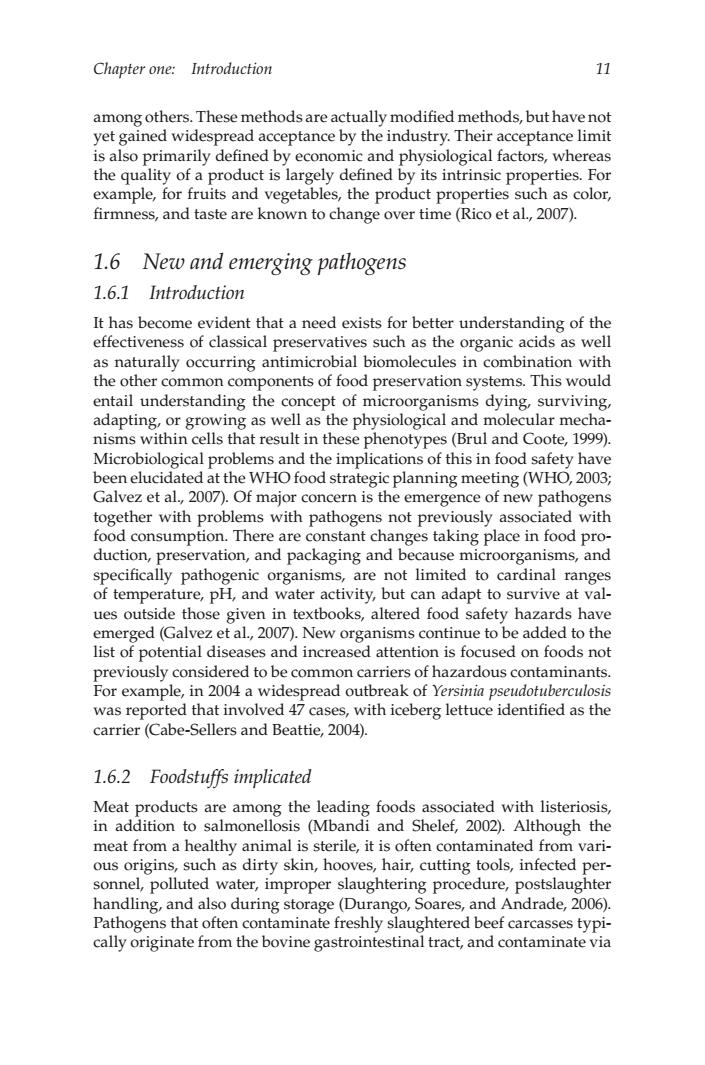正在加载图片...

Chapter one:Introduction 11 among others.These methods are actually modified methods,but have not yet gained widespread acceptance by the industry.Their acceptance limit is also primarily defined by economic and physiological factors,whereas the quality of a product is largely defined by its intrinsic properties.For examplefor fruits and vegetables,the product properties such as co firmness,and taste are known to change over time(Rico et al,2007). 1.6 New and emerging pathogens 1.6.1 Introduction effectivene as naturally occurring antimicrobial biomolecules in combination with the other common components of food preservation systems.This would entail understanding the concept of microorganisms dying,surviving, adapting.or growing as well as the physiologi ical and molecular mecha. nisms within cells that result in these pes(Brul and Coote,1999). ical pro nd the in of this in food safet e WHO foo d strategic planning mee Galvez et al,2007).Of major concern is the emergence of new pathogens together with problems with pathogens not previously associated with food consumption.There are constant changes taking place in food pro- duction,preservation,and packaging and because microorganisms,and specifically pathogenic organisms are not limited to cardinal ranges of tem ater activity but can adapt to survive atv ues outside t hose given xtbooks, altered food safety ha hav emerged(Ga et al.,2007).New organisms continue to b to tn list of potential diseases and increased attention is focused on foods not previously considered to be common carriers of hazardous contaminants. For example,in 2004 a widespread outbreak of Yersinia pseudotuberculosis was reported that involved 47 cases,with iceberg lettuce identified as the carrier(Cabe-Sellers and Beattie,2004). 1.6.2 Foodstuffs implicated Meat products are among the leading foods associated with listeriosis in addition to salmonellosis (Mbandi and Shelef,2002).Although the meat from a healthy animal is sterile,it is often contaminated from vari- ous origins.such as dirty skin.hooves.hair.cutting tools.infected per- sonnel polluted water handling,and also during storage( Dur drade,2006) Pathogens th ango, and An t often contaminate fres y aug htere eef carcasses typi cally originate from the bovine gastrointestinal tract,and contaminate via Chapter one: Introduction 11 among others. These methods are actually modified methods, but have not yet gained widespread acceptance by the industry. Their acceptance limit is also primarily defined by economic and physiological factors, whereas the quality of a product is largely defined by its intrinsic properties. For example, for fruits and vegetables, the product properties such as color, firmness, and taste are known to change over time (Rico et al., 2007). 1.6 New and emerging pathogens 1.6.1 Introduction It has become evident that a need exists for better understanding of the effectiveness of classical preservatives such as the organic acids as well as naturally occurring antimicrobial biomolecules in combination with the other common components of food preservation systems. This would entail understanding the concept of microorganisms dying, surviving, adapting, or growing as well as the physiological and molecular mechanisms within cells that result in these phenotypes (Brul and Coote, 1999). Microbiological problems and the implications of this in food safety have been elucidated at the WHO food strategic planning meeting (WHO, 2003; Galvez et al., 2007). Of major concern is the emergence of new pathogens together with problems with pathogens not previously associated with food consumption. There are constant changes taking place in food production, preservation, and packaging and because microorganisms, and specifically pathogenic organisms, are not limited to cardinal ranges of temperature, pH, and water activity, but can adapt to survive at values outside those given in textbooks, altered food safety hazards have emerged (Galvez et al., 2007). New organisms continue to be added to the list of potential diseases and increased attention is focused on foods not previously considered to be common carriers of hazardous contaminants. For example, in 2004 a widespread outbreak of Yersinia pseudotuberculosis was reported that involved 47 cases, with iceberg lettuce identified as the carrier (Cabe-Sellers and Beattie, 2004). 1.6.2 Foodstuffs implicated Meat products are among the leading foods associated with listeriosis, in addition to salmonellosis (Mbandi and Shelef, 2002). Although the meat from a healthy animal is sterile, it is often contaminated from various origins, such as dirty skin, hooves, hair, cutting tools, infected personnel, polluted water, improper slaughtering procedure, postslaughter handling, and also during storage (Durango, Soares, and Andrade, 2006). Pathogens that often contaminate freshly slaughtered beef carcasses typically originate from the bovine gastrointestinal tract, and contaminate via